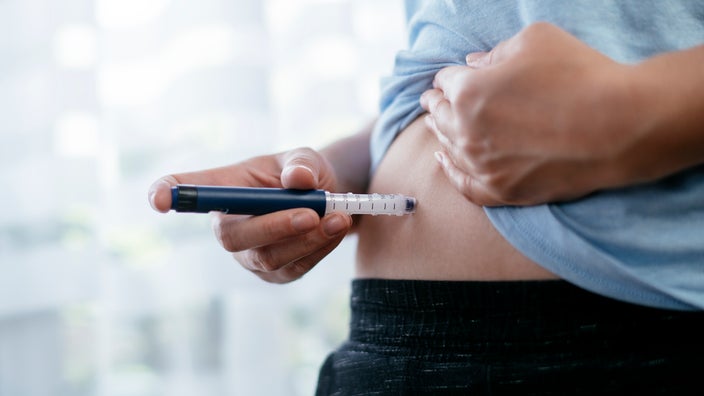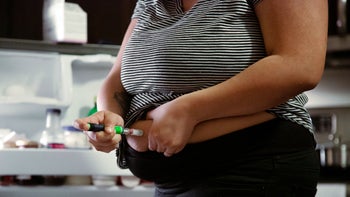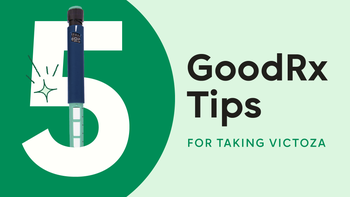Can Victoza Help You Lose Weight?
Key takeaways:
Victoza (liraglutide) is an injectable medication that’s FDA approved to treat Type 2 diabetes. It can also lower the risk of serious heart-related health problems for adults with both heart disease and Type 2 diabetes.
Even though Victoza isn’t FDA approved for weight loss, it has been shown to help people lose weight. A higher-dose liraglutide product, Saxenda, is FDA approved for weight loss for certain groups of people.
The FDA-approved dose of Saxenda (3 mg) has been shown to cause greater weight loss than the FDA-approved doses of Victoza (1.2 mg and 1.8 mg).
Access savings on related medications

Obesity has become increasingly common in the U.S. At the turn of the century, about 30% of U.S. adults were considered obese. By 2020, this number increased to more than 40%. Obesity raises the risk of conditions such as high blood pressure and heart disease.
If you’re considered overweight or obese, your healthcare team may recommend that you try to lose weight. Or, this could be one of your personal health goals. Either way, medications may be part of your weight-loss plan. Victoza (liraglutide) is one medication that’s known to cause weight loss, but it’s not FDA approved for this reason. It’s approved to treat Type 2 diabetes.
In 2020, the FDA approved another liraglutide product to help with weight loss in certain groups of people. This liraglutide product is called Saxenda. But if Victoza and Saxenda both contain liraglutide, can Victoza help you lose weight too?
Save over 40% on Qsymia with GoodRx
Discover the once daily Qsymia for weight management. Qsymia is for adults and children 12-17 in combination with a healthy diet and regular exercise.

Is Victoza FDA approved for weight loss?
No, Victoza isn’t approved for weight loss. Victoza is an injectable medication that’s approved to lower blood glucose (blood sugar) in people ages 10 and older living with Type 2 diabetes. It’s also approved to lower the risk of cardiovascular events (like heart attack and stroke) in people with diabetes and cardiovascular disease (like coronary artery disease or peripheral artery disease).
A different liraglutide product, Saxenda, was FDA approved in 2014 to help certain groups of people lose weight. This includes:
Adults who are considered obese
Adults who are considered overweight and have at least one weight-related health condition, such as high blood pressure, high cholesterol, or Type 2 diabetes
Kids, ages 12 and older, who are considered obese and weigh at least 132 lbs (60 kg)
Both medications are meant to be used in combination with a nutritious diet and routine exercise.
Good to know: Victoza is given once a day. It comes as a prefilled, multi-dose injector pen and is injected subcutaneously (underneath the skin). Each pen contains 18 mg of liraglutide. A generic version of Victoza is also available.
How does Victoza work for weight loss and diabetes?
Liraglutide is a glucagon-like peptide-1 (GLP-1) receptor agonist. It works by mimicking the effects of GLP-1, a type of incretin hormone.
Your gut makes incretin hormones like GLP-1 after you eat. GLP-1 sends signals to your pancreas to release insulin. By mimicking GLP-1, liraglutide increases the amount of insulin that’s released. This helps keep your blood sugar well managed.
GLP-1 also increases the amount of time it takes for food to travel through your digestive tract. And it blocks a hormone (glucagon) that causes your liver to release sugar. These actions help lower your appetite, and can lead to weight loss.
How effective is Victoza for weight loss?
Victoza has been shown to help people who have diabetes lose weight. This is important because weight loss can improve Type 2 diabetes and help you avoid related complications, such as heart problems. But Victoza can also help people who don’t have diabetes lose weight. Let’s take a look.
Victoza for weight loss in people who have diabetes
One study of over 700 people with Type 2 diabetes found that two different doses of Victoza led to weight loss. People using Victoza 1.8 mg lost about 5.5 lbs (2.5 kg), while those using Victoza 1.2 mg lost about 2.1 kg (4.6 lbs) after 1 year.
Another study compared liraglutide 3 mg and liraglutide 1.8 mg to placebo (an injection with nothing in it). The researchers found that both doses helped people with Type 2 diabetes lose more body weight than placebo. The study lasted 56 weeks, or just over a year.
How they compare: Victoza (liraglutide) and Ozempic (semaglutide) are both injectable medications for Type 2 diabetes. Learn more about how they compare.
Victoza tips: Explore pharmacist-backed tips for how to get the most from Victoza.
A generic GLP-1: Victoza is now available as a generic product. Here’s what you should know about its launch.
What’s more, in the same study, liraglutide 3 mg caused more weight loss than liraglutide 1.8 mg. People receiving liraglutide 3 mg lost an average of 6.4 kg (14 lbs). People using liraglutide 1.8 mg lost about 5 kg (11 lbs). Liraglutide 3 mg helped a significant amount of people lose more than 10% of their initial body weight.
Victoza for weight loss in people who don’t have diabetes
Most studies of the use of liraglutide in people without diabetes focus on the 3 mg dose (the dose used in Saxenda). Victoza isn’t used at this dose; the maximum recommended daily dose of Victoza is 1.8 mg.
That said, one study compared four doses of liraglutide (1.2 mg, 1.8 mg, 2.4 mg, and 3 mg) and found that all doses led to more weight loss than placebo. However, only the 3 mg dose resulted in more than a 5% weight loss for a significantly higher number of people compared to placebo. The study also compared liraglutide with another weight-loss drug, orlistat (Xenical). Only the 2.4 mg and 3 mg doses of liraglutide resulted in significantly more weight loss than orlistat.
In another study of over 3,500 people, liraglutide 3 mg contributed to an average weight loss of 8.4 kg (18.5 lbs), much higher than the 2.8 kg (6 lbs) lost with the placebo. It's worth noting that participants were encouraged to exercise regularly and follow a nutritious diet during the study.
What are the side effects of Victoza?
As with any medication, Victoza can cause unwanted side effects. Some of these side effects may improve over time as your body gets used to the medication.
Common Victoza side effects include:
Nausea and vomiting
Diarrhea
Constipation
Headache
Lowered appetite
Upset stomach
Injection site reactions
In rare cases, Victoza can lead to serious side effects that require immediate medical attention. One serious side effect is the risk of thyroid C-cell tumors. While these types of tumors have only been seen in animal studies, you should still avoid Victoza (and Saxenda) if you have a personal or family history of certain thyroid cancers. Victoza and Saxenda have a boxed warning for this risk, which is the FDA’s strictest warning for a medication.
Other serious risks include:
Hypoglycemia (low blood sugar)
Pancreatitis (inflammation of the pancreas)
Gallbladder problems, including gallstones and inflammation)
Kidney problems
Serious allergic reactions, including anaphylaxis
Frequently asked questions
No, Victoza is not a type of insulin. Rather, it’s a medication that mimics a hormone in the body called GLP-1. One of Victoza’s actions is to stimulate the body to produce more insulin after you eat. Insulin is a hormone that helps manage your blood sugar. But Victoza doesn’t contain insulin.
There aren’t any strict rules for foods to avoid while you’re prescribed Victoza. But it’s a good idea to limit certain foods to help reduce side effects. Greasy and fried foods can make nausea and digestive issues worse, so it’s best to avoid them. And sugary foods and drinks can spike blood sugar and reduce Victoza’s effectiveness, so try to cut back on them. Be mindful of alcohol, too, as it can increase the risk of low blood sugar when paired with Victoza.
Victoza is an injection given underneath the skin. But there are other diabetes medications that can be taken orally. Like Victoza and Saxenda, some of these diabetes pills may help people lose weight. But others may lead to weight gain.
The bottom line
Victoza (liraglutide) is a glucagon-like peptide-1 (GLP-1) receptor agonist that’s FDA approved to treat Type 2 diabetes. It’s an injection that’s given underneath the skin once daily. In studies, it’s been shown to help with weight loss in people with and without diabetes. But it’s not specifically FDA approved for this reason.
Another medication, Saxenda, with the same active ingredient as Victoza (liraglutide) is FDA approved for weight loss. Saxenda is approved at a higher dose (3 mg) than Victoza (1.2 and 1.8 mg). The 3 mg dose has been shown to be more effective than lower doses at helping people lose weight.
Why trust our experts?



References
Astrup, A., et al. (2009). Effects of liraglutide in the treatment of obesity: A randomised, double-blind, placebo-controlled study. The Lancet.
Centers for Disease Control and Prevention. (2024). Adult obesity facts.
Collins, L., et al. (2024). Glucagon-like peptide-1 receptor agonists. StatPearls.
Davies, M. J., et al. (2015). Efficacy of liraglutide for weight loss among patients with type 2 diabetes: The SCALE diabetes randomized clinical trial. JAMA.
Deane, A. M., et al. (2010). Endogenous glucagon-like peptide-1 slows gastric emptying in healthy subjects, attenuating postprandial glycemia. The Journal of Clinical Endocrinology & Metabolism.
Novo Nordisk. (2025). Saxenda- liraglutide injection, solution [package insert]. DailyMed.
Novo Nordisk. (2025). Victoza- liraglutide injection [package insert]. DailyMed.
Pi-Sunyer, X., et al. (2015). A randomized, controlled trial of 3.0 mg of liraglutide in weight management. The New England Journal of Medicine.
U.S. Food and Drug Administration. (2021). FDA approves weight management drug for patients aged 12 and older.
Wilding, J. P. H. (2014). The importance of weight management in type 2 diabetes mellitus. International Journal of Clinical Practice.
Was this page helpful?
Related Articles
Browse medications
View AllResearch prescriptions and over-the-counter medications from A to Z, compare drug prices, and start saving.




























